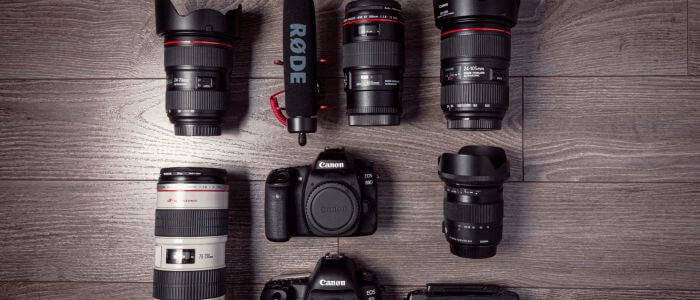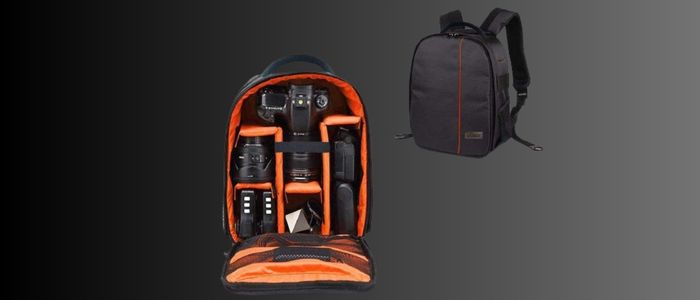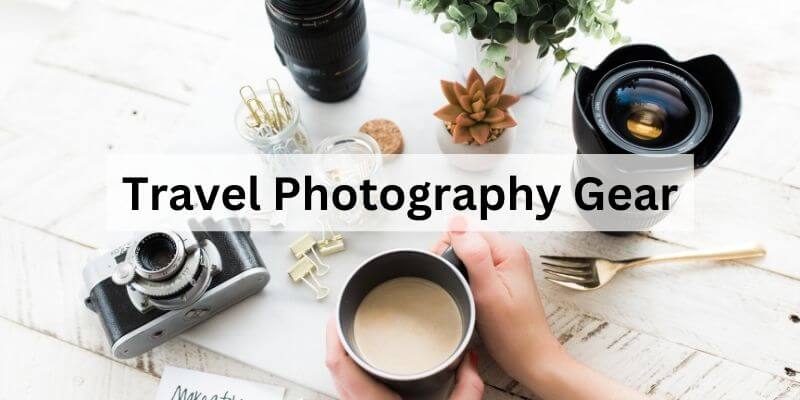Travel photography has evolved into an art form that not only captures stunning vistas but also communicates engaging stories in an era when wanderlust is at its pinnacle. With each shutter release, you capture a moment in time, keeping the essence of your travels for posterity.
The world of trip photography gear, on the other hand, maybe both interesting and intimidating for those looking to go on this visual experience. The options are numerous, the technology is always developing, and the stakes are enormous. But don’t worry; we’re about to start on our adventure, one that will simplify the complicated world of travel photography gear.
The world of travel photography! It’s a captivating journey filled with exciting adventures and incredible memories waiting to be captured. Whether you’re wandering through the vibrant streets of Southeast Asia or exploring the scenic landscapes of the United States, having the perfect travel photography gear can truly transform your experience. In this guide, we’ll walk you through the must-have equipment for every aspiring travel photographer.
While there are countless options for camera equipment out there That Help to take Good shots while traveling. Let’s dive in and discover how the right gear can elevate your photography game and help you create stunning images that stand the test of time.
Connecting with the Aspiring Photographer
Consider yourself standing on a sun-kissed Mediterranean beach. The turquoise waves lap against the pebble-strewn shore. A salty air conveys the perfume of adventure, and the sun casts a golden light over everything. You lift your camera to your eye, and the world comes to a halt. This is the brilliance of trip photography. It is more than just a snapshot; it contains memories and feelings. However, to capture such moments, the proper equipment is required.
Let us start with the camera. A good travel camera should be adaptable, small, and durable. Mirrorless cameras, such as the Sony Alpha series or the Fujifilm X-T4, provide great image quality and mobility for those just starting. Their interchangeable lenses enable creative exploration, making them ideal partners for a wide range of shooting situations. For unrivaled image quality and sophisticated capabilities, seasoned travelers may prefer full-frame DSLRs such as the Canon EOS 5D or Nikon D850.
Capturing the spirit of a place’s distinct ambiance is an important aspect of travel photography. To do so, you’ll need to invest in high-quality lenses. Wide-angle lenses, like as the 16-35mm, are ideal for capturing expansive vistas and architectural marvels. A prime lens, such as a 50mm, is ideal for street photography and portraiture. If you want to photograph animals, a telephoto lens with a large focal length will get you closer to the action.
Essential Travelling photography gears
Essential travel photography gear includes the following:
Camera Body

A high-quality camera body is the heart and soul of your photography setup. Whether you’re drawn to the versatility of a mirrorless camera or the robustness of a DSLR, the choice is yours. The camera body houses the sensor, which captures light and transforms it into mesmerizing digital imagery. When seeking a camera body, focus on reliability and exceptional image quality. This foundation ensures your photos are sharp, noise-free, and brimming with life.
There are many different types of camera bodies available, each with its own set of features and capabilities. DSLR cameras are popular among photographers who value versatility and image quality. While mirrorless cameras are favored by those who prioritize portability and ease of use. Both types of cameras can produce excellent image quality, so the choice between them often comes down to personal preference.
Here are some popular options:
- Mirrorless Cameras: Mirrorless cameras are lightweight and compact, making them ideal for travel. Models like the Sony Alpha series and Fujifilm X-T4 offer excellent image quality and versatility.
- DSLR Cameras: DSLRs like the Canon EOS 5D Mark IV or Nikon D750 provide exceptional image quality and a wide range of lenses.
- Compact Cameras: High-end compact cameras, such as the Sony RX100 VII, are perfect for travelers who want portability without sacrificing image quality.
When choosing a camera body, it’s important to consider factors like image quality, autofocus performance, shooting speed, and ergonomics. Additionally, features like image stabilization, weather-sealing, and connectivity options can also be important depending on your shooting needs.
Lenses

A versatile zoom lens is an excellent choice for travel photography. As it allows you to capture a wide range of scenes and subjects. Additionally, a wide-angle lens can be helpful for landscape and architectural photography. While a telephoto lens can be useful for capturing wildlife and other distant subjects. Lenses are responsible for focusing light onto the camera sensor, which is what creates the image that you see. Choosing the right lens for your needs can be a challenging process, as there are many different types of lenses available, each with its own set of features and capabilities.
Consider these lens options:
- Wide-Angle Lens: A wide-angle lens, like a 16-35mm, is perfect for landscape shots and capturing the grandeur of natural wonders.
- Standard Zoom Lens: A versatile lens, such as a 24-70mm, covers a broad focal range and is suitable for various shooting situations.
- Telephoto Lens: A telephoto lens, such as a 70-200mm, is excellent for capturing distant subjects, wildlife, and portraits.
When choosing a lens, it’s important to consider factors like focal length, aperture, image stabilization, and lens construction. Additionally, it’s important to choose a lens that is compatible with your camera body and that meets your shooting needs.
Overall, lenses are a crucial component of any camera system and for your Travel photography gear, and choosing the right lens for your needs can make a significant difference in the outcome of your photographs. With a bit of research and experimentation, you can find the perfect lens to help you capture stunning photos.
Tripod

A sturdy tripod can be an invaluable tool for travel photography, especially when shooting in low light or trying to capture long exposures. Look for a tripod that is lightweight and compact, so you can easily carry it with you on your travels. Tripods are essential for many types of photography, including landscape, architecture, and long-exposure photography. A tripod allows you to keep your camera steady and reduce camera shake, which can result in sharper, more detailed images.
When choosing a tripod, it’s important to consider factors like weight, stability, and height. A lightweight tripod is essential for travel photography, as it’s easy to carry and won’t weigh you down during long hikes or walks. A stable tripod is important for ensuring that your camera stays in place and doesn’t wobble or shake, especially during long exposures. A tripod with adjustable height can be useful for achieving different perspectives and angles.
Tripods can also come with a variety of additional features, such as ball heads, which allow you to adjust the angle and orientation of your camera, and quick-release plates, which allow you to quickly and easily attach and detach your camera from the tripod.
Overall, a tripod is an essential tool for any photographer, as it allows you to capture sharp, detailed images and opens up new possibilities for creative expression. When choosing a tripod, make sure to choose one that is lightweight, stable, and adjustable, and that meets your specific shooting needs.
Extra Batteries and Memory Cards

Extra batteries and memory cards are essential accessories for any photographer, especially when traveling or shooting for extended periods. Having additional batteries and memory cards on hand ensures that you won’t run out of power or storage space when you need it most.
Batteries are the power source for your camera, and having a spare battery can mean the difference between capturing that perfect shot or missing it altogether. When choosing extra batteries, it’s important to choose ones that are compatible with your camera model and that have a high capacity to ensure that they last as long as possible.
Memory cards are where your camera stores the photos that you take, and having additional memory cards ensures that you won’t run out of storage space. When choosing memory cards, it’s important to choose ones that are compatible with your camera and that have a high capacity and fast read/write speeds. This ensures that you can capture and transfer photos quickly and easily.
Camera Batteries:
- Canon LP-E6 / LP-E6N Battery:
- Compatible with many Canon DSLRs, including the EOS 5D series and 7D series.
- Consider buying the official Canon battery or reputable third-party options like Wasabi Power or Watson.
- Nikon EN-EL15 Battery:
- Compatible with Nikon DSLRs like the D7000 series and D800 series.
- Official Nikon batteries are dependable, but alternatives like Watson or RavPower can be more affordable.
- Sony NP-FW50 Battery:
- Works with Sony mirrorless cameras like the Alpha A7 series and A6xxx series.
- Stick to genuine Sony batteries or trusted third-party brands like Wasabi Power or Newmowa.
- Panasonic DMW-BLC12 Battery:
- Compatible with Panasonic Lumix cameras such as the GH3 and GH4.
- Opt for Panasonic-branded batteries or trusted alternatives like Powerextra.
- Fujifilm NP-W126 / NP-W126S Battery:
- Designed for Fujifilm X-Series mirrorless cameras.
- Fujifilm’s batteries are reliable, but you can also consider brands like Wasabi Power.
Memory Cards
- SanDisk Extreme Pro:
- Known for high-speed performance and reliability.
- Available in various capacities and compatible with most cameras.
- Sony Tough Series SD Cards:
- Resistant to water, dust, and shock, making them suitable for rugged conditions.
- Offer high-speed performance.
- Lexar Professional 2000x SD Card:
- Provides fast read and write speeds, ideal for 4K video and high-resolution photography.
- Lexar is a trusted brand in the memory card industry.
- Samsung EVO Plus MicroSD Card:
- Excellent for action cameras and drones.
- Offers reliable performance and comes with an adapter for use in standard SD card slots.
- ProGrade Digital SD Cards:
- Known for their high-speed performance and reliability.
- Available in various capacities and designed for professional use.
Camera Bag

A camera bag is an essential accessory for any photographer, as it provides a convenient and safe way to carry your camera and other photography gear. Camera bags come in a variety of sizes and styles, from small shoulder bags to large backpacks, and choosing the right bag depends on your specific needs and preferences. A durable camera bag is essential for protecting your camera and lenses during travel. Look for a bag that is weather-resistant and has plenty of compartments to organize your gear.
When choosing a camera bag, it’s important to consider factors like size, weight, durability, and comfort. A bag that is too small may not be able to hold all of your gear, while a bag that is too large may be too heavy or cumbersome to carry around. A durable bag is important to protect your gear from the elements, while a comfortable bag can make it easier to carry your gear for extended periods of time.
Camera bags often come with a variety of compartments and pockets, which allow you to organize your gear and access it quickly and easily. Some bags also come with additional features like waterproofing, adjustable dividers, and straps for attaching a tripod or other accessories.
Here are some popular types of camera bags and factors to consider when selecting one as your Travel photography gear:
- Camera Backpack:
- Ideal for travelers and hikers who need to carry a significant amount of gear comfortably.
- Offers excellent weight distribution and often has compartments for a laptop or tablet.
- Look for models with adjustable dividers and padded shoulder straps for comfort.
- Camera Shoulder Bag:
- Suitable for photographers who want quick access to their gear while on the move.
- Typically smaller and may only accommodate a camera body and a couple of lenses.
- Consider a bag with adjustable dividers, padded inserts, and a durable, water-resistant exterior.
- Camera Sling Bag:
- Combines the convenience of a shoulder bag with the carrying comfort of a backpack.
- Designed for quick access to gear while maintaining a more balanced weight distribution.
- Look for models with customizable interior layouts and ergonomic straps.
- Rolling Camera Bag:
- Ideal for photographers with heavy equipment or those who don’t want to carry a bag on their back.
- Offers wheels and a telescoping handle for easy transport.
- Ensure it’s well-padded to protect your gear during travel.
- Camera Holster Bag:
- Designed for one camera body with a lens attached, making it suitable for quick shooting.
- Offers easy access to your camera without having to open a flap or zipper.
- Some models have additional pockets for small accessories.
Filters

Filters are accessories that attach to the front of a camera lens and alter the way that light enters the lens. It can be used for a variety of purposes, including enhancing colors, reducing glare, and achieving special effects like long exposures or blurred motion.
One of the most common types of filters is a polarizing filter, which can reduce glare and reflections from surfaces like water, glass, or metal. Polarizing filters can also enhance the colors in a scene, making blues and greens appear more vivid.
Consider these filters:
- UV Filter: Protects your lens from dust and scratches.
- Circular Polarizer: Reduces reflections and enhances colors, especially in landscapes.
- Neutral Density (ND) Filter: Allows you to use slow shutter speeds for creative effects like silky waterfalls or blurring moving subjects.
Neutral density (ND) filters are another popular type of filter, which can reduce the amount of light that enters the lens. This can be useful for achieving long exposures in bright daylight conditions or for using wider apertures in bright light, without overexposing the image.
Other types of filters include graduated ND filters, which are used to balance the exposure of a scene with bright and dark areas, and color filters, which can enhance or alter the colors in a scene.
Overall, filters are an essential accessory for many types of photography, as they allow you to control and manipulate the light entering your lens, and achieve creative effects that would be difficult or impossible to achieve otherwise. It is the most important Travel photography gear.
Travel photography Gear Bonus: Extra Accessories
In addition to the essential travel photography gear mentioned earlier, there are a few extra accessories that can come in handy when traveling or shooting on location.
- Remote Shutter Release: A remote shutter release allows you to trigger the shutter of your camera without touching it, which can be useful for minimizing camera shake and achieving sharp images in low light conditions.
- Lens Cleaning Kit: A lens cleaning kit is essential for keeping your lenses clean and free of dust and debris, which can affect image quality. A basic kit should include a microfiber cloth, lens cleaning solution, and a brush for removing dust.
- External Flash: An external flash can be useful for adding additional light to your photos, especially in low-light conditions or when shooting indoors. An external flash can also be used to create a more dramatic or creative lighting effect.
- Camera Strap: A comfortable and secure camera strap is essential for carrying your camera around safely and comfortably, especially when traveling or shooting for extendedperiodse. Choose a strap that is adjustable, durable, and comfortable to wear.
- Rain Cover: A rain cover can protect your camera and other gear from rain and other types of moisture, which can be especially important when shooting in wet or humid environments.
Overall, these extra accessories can make your travel photography experience more enjoyable and efficient. By providing additional functionality, comfort, and protection for your gear.
Technical Camera Terms You’ll Need To Learn
Understanding technical camera terms is crucial for mastering photography. Here are some important camera-related terms you should learn for your Travel photography gear:
- Aperture (f-stop):
- The adjustable opening in the lens through which light enters the camera. It’s measured in f-stops, e.g., f/1.8, f/2.8, and controls the amount of light and depth of field.
- Shutter Speed:
- The amount of time the camera’s sensor or film is exposed to light. It’s measured in seconds or fractions of a second (e.g., 1/1000s, 1s) and affects motion blur and exposure.
- ISO (Sensitivity):
- The camera’s sensitivity to light. Higher ISO values (e.g., ISO 1600) are used in low-light situations but can introduce noise or grain in photos.
- Exposure:
- The total amount of light that reaches the camera sensor or film. It’s controlled by the combination of aperture, shutter speed, and ISO settings.
- Metering:
- The camera’s system for measuring and calculating the exposure. Common modes include spot, center-weighted, and evaluative (matrix) metering.
- Focal Length:
- The distance from the lens to the image sensor is measured in millimeters. It determines the field of view and magnification of the lens (e.g., 50mm, 200mm).
- Depth of Field (DOF):
- The range of distances in a photo that appears acceptably sharp. It’s controlled by the aperture setting; a wide aperture (e.g., f/1.8) results in a shallow DOF, while a narrow aperture (e.g., f/16) results in a deep DOF.
- Bokeh:
- The aesthetic quality of the out-of-focus areas in a photograph is often characterized by creamy, blurred backgrounds. Achieved with a wide aperture.
- White Balance (WB):
- Adjusts the color temperature of the photo to match the lighting conditions, ensuring accurate color representation.
- RAW vs. JPEG:
- File formats for saving images. RAW files contain unprocessed data, allowing for more extensive post-processing. JPEG files are compressed and suitable for direct use.
Conclusion
Any voyage is, of course, incomplete without recollection. Memory cards are similar to travel journals. Invest in high-capacity, fast-write cards to avoid missing a beat. Carrying spares and an extra hard drive for backup is also a smart idea.
Let’s not forget about the extras. Long-exposure pictures and self-portraits require a strong tripod. A camera bag built specifically for vacation photographers will keep your equipment secure and tidy. Polarizers and ND filters, for example, improve your photographs while also protecting your lens from bright light.
When choosing travel photography gear, it’s important to consider factors like size, weight, durability, and functionality. As well as your specific shooting style and needs. Investing in high-quality gear that is tailored to your specific needs can help you achieve better results. Make your photography experience more enjoyable and efficient.
Additionally, it’s important to remember that the best photography gear is not always the most expensive or high-tech. With the right skills and techniques, even basic gear can produce stunning results.
Overall, whether you are an amateur or professional photographer. Choosing the right travel photography gear can help you capture stunning images that will be cherished for a lifetime. So, take the time to choose the right gear for your needs. Get ready to capture some amazing shots on your next travel adventure!
You May Also Like:

